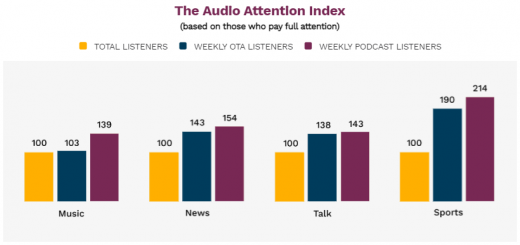How Audio Behaviors Are Changing in 2021
I hate to start any lengthier post or story with ‘the pandemic has impacted/changed X’ because it sounds like a cliché by now. It’s also true – facts are facts. How we work and interact has been reshaped by the ongoing pandemic. In turn, we significantly changed our media habits, particularly those that pertain to our aural intake.
Mind you – these are changes that aren’t going away anytime soon. I’ll explain why.
No commute – no problem
First of all, to say that COVID-19 is single-handedly responsible for this shift would be irresponsible of me. The focus shift to eardrums has been long in the works, driven by the newfound convenience of listening at your behest and evolving tech capabilities. It’s just that in 2020, all of it was more pronounced than ever before.
Let’s start with the commute, one of the favorite listening times. It virtually disappeared overnight, experiencing its own flattening of the curve. After the initial dip where podcasts took the brunt of the damage, it was largely expected to see further dramatic decline in listening. However, audiences came back, so much so that time spent with digital audio increased 8.3% to 1 hour and 29 minutes per day. Furthermore, it’s expected to increase another 4.8% this year.
Why?
Because the loss of commuting time means that people are simply listening at different times, most notably at home. While there may not be spikes during commute times anymore, there also aren’t any significant drop-offs during the day. It’s spread out more throughout the day, as Reuters’ brilliant research on daily news podcasts has shown.

For news articles, our little data excavation has shown that morning hours between 7h and 10h, as well as evening sessions between 17h and 20h are when users are doing the most listening. All of this indicates that people are engaging more frequently, filling different open times.
Case in point: in its annual summary of trends that shaped streaming in 2020, Spotify presented a few interesting points, starting with the obvious uptick in people streaming from home. Many did so by way of the topical playlists they created, but there was also a huge increase in the number of people streaming from gaming consoles. Apart from ripping and tearing through demons in Doom Eternal or revisiting the 90s nostalgia with Tony Hawk’s Pro Skater, people found time to listen to their favorite artists and podcasts via the same device.
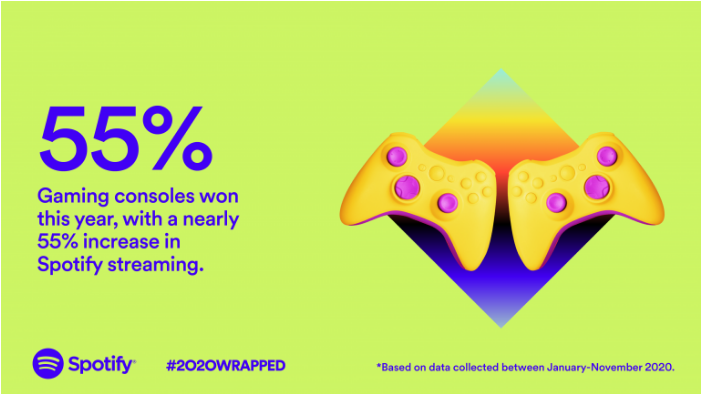
Going forward, commute times will eventually return (fingers crossed for soon), which may again shift some of the listening to pre-pandemic times – but only slightly. Flexible work schedules will stick for the foreseeable future, meaning there will be more interweaving of work and “play” during work hours.
Also, let’s not forget that most new cars (where a lot of listening happens or used to happen) will have Internet connections, making access to audio content easier and quicker. With the ‘car as an entertainment platform’ concept further developing, there are more opportunities to reach audiences outside of the traditional primetime, as well as more flexibility to create and maintain close relationships. This means more varied content, which should help slightly increase audio consumption behind the wheel.
People are finding out audio content is multipurpose (and healing)
Another factor that needs to be considered is the general sentiment we felt all those yearsmonths ago when lockdowns and quarantines kicked in. Suddenly, the world became this bleak, depressing place in no small part thanks to the media coverage. You can take only so much negative news and emotional beating. Back in late April 2020, 71% of U.S adults said they needed to take breaks from news about the coronavirus. Mind you, that was barely two full months when the outbreak “officially” started in the country.
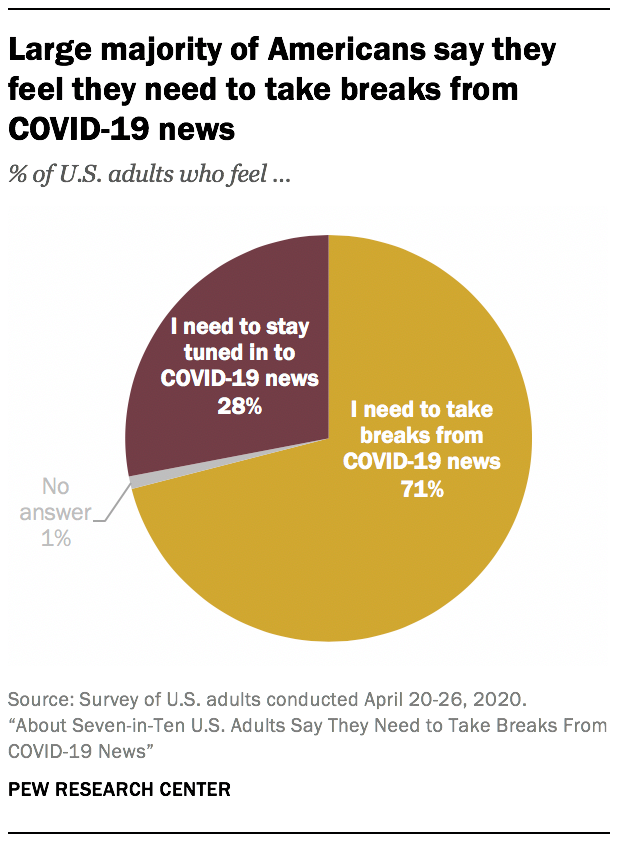
So, people needed breaks every once in a while and they found it in audio, along with streaming video and gaming.
For example, the Spoken Word Audio Report revealed that the share of time spent listening to spoken word audio in the U.S. has increased 8% in 2020. The report also shows a fascinating array of reasons why people listen to more spoken word audio than ever before.
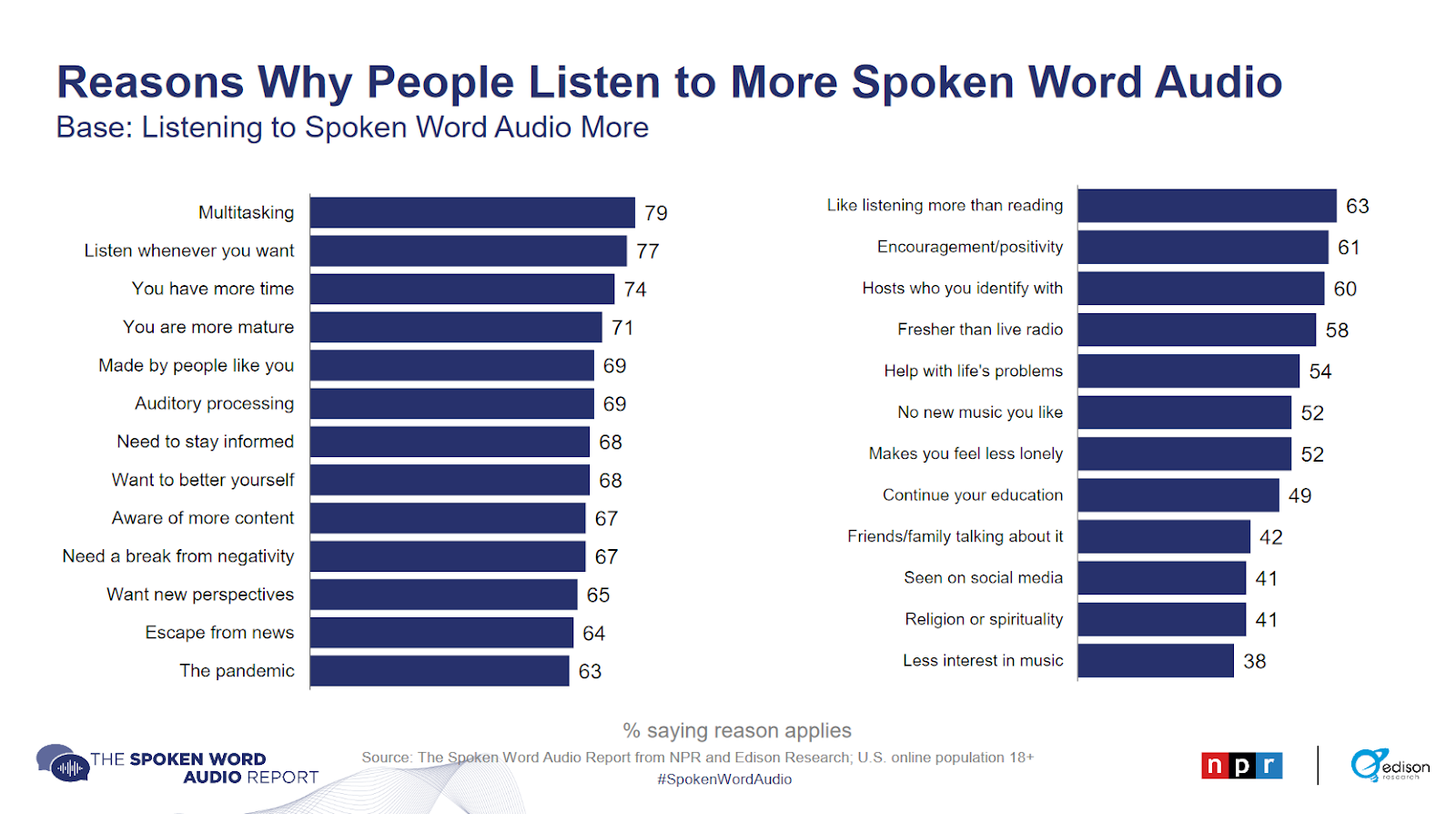
Just look at that slide. Multitasking benefits and high convenience are obvious but I was pleasantly surprised to discover that listeners also place personal growth and the ability to improve mental health high up on the list to tune in regularly.
The possibility to better oneself, get motivated and encouraged, or simply absorb some positivity are among the most surprising perceptions that audio (spoken word, in particular) has on listeners. It’s being increasingly perceived as a means to escape the negativity and current events, as well as a way to navigate life’s problems and feel less lonely.
2020 was also full of discovery as according to Spotify, more and more people in the 18-24 age group listened to podcasts for the first time in 2020.
Simply put, people are finding out it’s worth their time to listen, especially since there’s so much content in virtually any imaginable format that suits even the pickiest of listeners.
That’s part of the reason why audio-only fitness apps are growing in popularity. Staring at a screen after a day of staring at a screen (for most of us) is probably the last conscious thing anyone wants. Screen saturation and Zoom fatigue are real so audio adds that much-needed dash of creativity when it comes to working out, meditating, doing yoga, and else.
Case in point: Apple’s recent launch of an audio walking experience which maximizes the medium’s portability and ultimately, convenience. It seems like a neat hybrid of meditative and location-based immersive audio experiences with a distinct health benefit. I can see how this could push audio-only fitness more into the mainstream as more businesses discover audio’s ease of scaling and affordability. And as a runner and an avid meditation buff, I can totally picture myself going for a product like this.
Speaking of audio-only:
“Audio is the future of social media”
I’m pretty sure it’s not the first nor is it the last time you’ll read and hear that sentence.
As everyone’s favorite argument, Clubhouse is the example of hype surrounding the audio-only approach to social media. Very few things (if anything) can replace or mimic the intimacy of the spoken word. Audio messaging has been around for years, which acted as a springboard for this new wave of hip audio apps such as Clubhouse, Cappuccino, and other audio-first upstarts. When you add Twitter developing its own version with the Audio Space feature and Discord opening its doors to everyone instead of just gamers, it’s clear that the path to integrating social media content into daily life is through eardrums.
The intimacy of our voices makes audio social media that much more appealing, particularly in times of social distancing. There’s the benefit of comprehension based on the speaker’s inflections or intonations as some nuances can only be communicated via audio. Implementing the immediacy and raw emotion of the medium into the core experience is driving people to connect via voice again, effectively coming full circle from the initial promise of cellphones.
It’s too early to tell how much of this virtual socialization will stick once things get back to old normal. However, the proof that audio format is the next frontier is not just in social media, though – it’s in media in general. With Netflix introducing audio-only background playback on Android and YouTube rolling out audio-only ads when listening to music and podcasts in the background on desktop, it’s becoming more and more obvious that being audio-centric as much as possible is an important component of the broader media ecosystem.
Publishers are riding on the coattails of audio immersion
A few weeks ago, there was a slightly different study about the impact of audio content, namely its immersive nature. The result showed that not only audio connects and engages audiences at a much deeper level than other media types, it’s forming emotional connections and capturing attention. In fact, audio was found to have the highest level of immersion compared to TV, video, social, and pureplay platforms. And – it’s ability to entice audiences and hold their full attention is fairly consistent across various categories and formats.
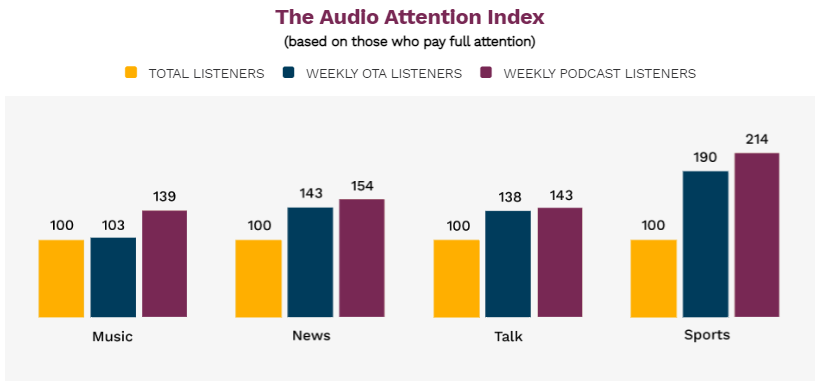
There was another important discovery in the study: people are inspired to take action through a sense of community and belonging. In other words, there’s indication that local content and hosts enjoy the highest consumer engagement level. This engagement builds emotion, attention and recall, empowering listeners to act based on ads and recommendations.
Looking at a broader scale, these new media habits and changing information needs have transformed publishers’ business models. Loyalty is a scarce but extremely valuable commodity for publishers. Hence, publishers who have adapted are now reporting audio and specific products as key drivers of subscription growth.
To borrow a line from the above article: the number of cases for how audio fits in with media companies’ subscription businesses is growing. Simply put, readers/listeners are paying for news to be delivered via eardrums. Listening is super easy to integrate into other experiences and its high immersion represents a great model to convey a few topical pieces of news and analysis each day, for instance.
If the publishing industry is able to capitalize on this audience behavior now, subscriptions could be the “easy” way out of the pandemic-fueled slump caused by diminished ad revenue. They could also be a sustainable way forward – all because audio delivers highly personal user experiences and reliable results for brands.
Final thoughts
To capitalize on the ongoing audio renaissance and this audio-first behavior, an audio strategy of some sorts is required. In this rapidly progressing space, there is no right or wrong answer about the proper format or correct length. The key is to put a strong emphasis on audience needs and adapt to their shifting listening habits. And despite what many are wondering – a lot of the changes in our media diet will remain for the time being, audio included.
By now, it should be clear that audio is more than able to engage people in deeper ways, perhaps even more than digital media has traditionally been able to. I often catch myself thinking how I browse most websites for a very short time but have no problem listening to their audio versions for 5-10 minutes or longer for podcasts.
The way I see it, there are two huge parts of COVID-19’s legacy, so to speak. One is the accelerated shift to digital audio where more people are embracing listening as either a complementary or dominant way of obtaining information. The other is an opportunity for fresh narratives to take advantage of this audio-friendly environment where other media players can’t or haven’t yet done so.
It’s a brave new digital world out there and how publishers anticipate and respond to current content needs (but also when the pandemic hopefully ends) is what will largely define them in the long run.
Image credits:
https://reutersinstitute.politics.ox.ac.uk/daily-news-podcasts-building-new-habits-shadow-coronavirus
https://newsroom.spotify.com/2020-12-01/the-trends-that-shaped-streaming-in-2020/
https://www.nationalpublicmedia.com/insights/reports/the-spoken-word-audio-report/
https://entercom.com/insights/audio-is-personal-primetime/
Digital & Social Articles on Business 2 Community
(39)

